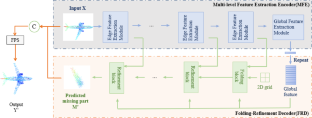The Visual Computer ( IF 3.5 ) Pub Date : 2024-04-09 , DOI: 10.1007/s00371-024-03354-x Luhan Wang , Jun Li , Shangwei Guo , Shaokun Han

|
Point cloud completion represents a complex task that entails predicting the complete geometry of a 3D shape from a set representation of the partial observational points. This paper presents a novel point cloud completion method, called Cascaded Graph Convolutional Completion Network (CGCN). Our method leverages a cascaded encoder–decoder architecture to predict the missing points from the input, the partial points. These predicted missing points are then concatenated with the input points to form the complete shape. Our architecture consists of two main modules: a Multi-Level Feature Extraction Encoder (MFE) and a Folding-Refinement Decoder (FRD). The MFE is composed of the Edge Feature Extraction Module (EFE) and the Global Feature Extraction Module (GFE). The encoder initiates by using several EFEs to secure multi-level local features through the execution of graph convolutional operations on each point. It then employs a GFE to extract global features from the final level features. Consequently, the MFE aggregates features containing local information into global features, offering an output that carries both local and global features. Our FRD contains both a folding block and several refinement blocks. Initially, the folding block morphs 2D grids with features output by the MFE to predict the initial missing points. The decoder then iteratively applies a series of refinement blocks to refine these initial missing points and eventually obtain the output of the predicted missing points. The FRD merges multi-level features and global features to deliver the shape of the predicted missing part. To achieve the complete shape, we integrate the predicted missing part, derived from the FRD and the input points. We then sample this unified point cloud to secure the final output. The effectiveness and competitiveness of our model are validated through experiments on the ShapeNet dataset, using Chamfer Distance (CD) as metrics.
中文翻译:

用于点云补全的级联图卷积网络
点云补全是一项复杂的任务,需要根据部分观测点的一组表示来预测 3D 形状的完整几何形状。本文提出了一种新颖的点云补全方法,称为级联图卷积补全网络(CGCN)。我们的方法利用级联编码器-解码器架构来预测输入中缺失的点(部分点)。然后将这些预测的缺失点与输入点连接起来以形成完整的形状。我们的架构由两个主要模块组成:多级特征提取编码器(MFE)和折叠细化解码器(FRD)。 MFE由边缘特征提取模块(EFE)和全局特征提取模块(GFE)组成。编码器首先使用多个 EFE,通过在每个点上执行图卷积运算来保护多级局部特征。然后它使用 GFE 从最终级别特征中提取全局特征。因此,MFE 将包含局部信息的特征聚合为全局特征,提供包含局部和全局特征的输出。我们的 FRD 包含一个折叠块和几个细化块。最初,折叠块使用 MFE 输出的特征对 2D 网格进行变形,以预测初始缺失点。然后,解码器迭代地应用一系列细化块来细化这些初始缺失点,并最终获得预测缺失点的输出。 FRD 合并多级特征和全局特征以提供预测缺失部分的形状。为了获得完整的形状,我们集成了从 FRD 和输入点导出的预测缺失部分。然后我们对这个统一的点云进行采样以确保最终的输出。我们的模型的有效性和竞争力通过 ShapeNet 数据集上的实验得到验证,使用 Chamfer Distance (CD) 作为指标。



























 京公网安备 11010802027423号
京公网安备 11010802027423号